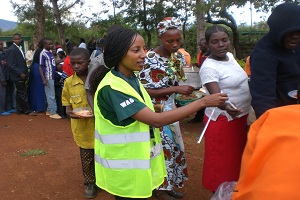OUR SERVICES
Youths Against Disasters (YADs) strategies primarily involves hazard identification, vulnerability analysis and risk assessment of the community guided by the Sendai Framework of Action four priority areas which include:
DISASTER RISK REDUCTION
Disaster risk reduction is the concept and practice of reducing disaster risk through systematic efforts to analyze and manage the casual factors of disasters, including through reduce exposure to hazards, lessened vulnerability an improve preparedness for adverse effects.
This shift in approach from disaster response to disaster risk reduction has been occasioned by the fact that society can't be without the occurrence of hazards due to natural processes and human activities.
Youths Against Disasters (YADs) strategies primarily involves hazard identification Vulnerability analysis and risk assessment of the community guide by the Sendai Framework of Action, four priority areas which include:
a) Understanding disaster risk
Youths Against Disasters (YADs) carries out hazard mapping and vulnerability analysis and encourages the communities to develop a culture of prevention as culture dictates how people perceive the risk and their motivation to enhance resilience. Based on the risk assessment and the understanding of the risk, we create awareness through training and workshops, forge accountability by encouraging the community to hold anyone to account for any activity that that has an effect on the environment, and empower individuals and thus we increase their resilience and enhance their well being.
b) Strengthening disaster risk governance to manage disaster risk
The government of Kenya has a responsibility of protecting the life and property of the people through the use of legal instruments like public policies that consist of a set of conditions that guide actions in the society. YADs, coordinate with the National Disaster Management Unit (NDMU), the National Disaster Operation Centre (NDOC) and all stakeholders in disaster management for effective and efficient management of disasters in Kenya.
c) Investing in disaster risk reduction for resilience
The local communities in Kenya are usually reluctant to take initiatives that enhance preparedness especially in places that have been affected by disasters on an annual basis and YADs encourages non structural measures of disaster risk reduction like community participation in preventive projects through empowerment to effectively be involved in shaping their cause of action and enhance resilience.
d) Enhancing disaster preparedness for effective response.
Youths Against Disasters ensures that capacities are in place to respond and recover from disasters. This is achieved through training and workshops to the local communities, creating awareness about hazard risk and the introduction of preventive technology. Each and every community in Kenya is unique in terms of location and the hazards prevalent in the areas although there are other hazards that are national in nature for example HIV and AIDS.

CAPACITY BUILDING
HIV AND AIDS

SUBSTANCE & DRUG ABUSE
